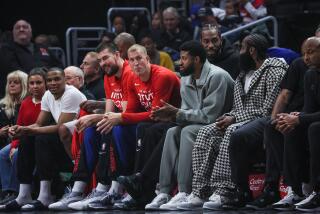A Search for a New Heart, New Life : Transplant Surgery Offers Youth’s Last Chance for Health
Leonard Pattnett, 11, took his first airplane ride last week--in search of a new heart and a new life.
With him were his favorite book, “Old Yeller,” and the person who had packed it for him, his mother, Earline Carr, a woman determined to find the best chance for life--a quality life--for her son.
They went by ambulance from Childrens Hospital of Los Angeles to Los Angeles International Airport, where, with a Stanford University Children’s Hospital team of two doctors, a nurse and a respiratory specialist, they boarded a Stanford medical plane and took off for Palo Alto.
By Friday, Leonard had been accepted at Stanford Children’s for heart transplant surgery. No one knows how long the wait for a suitable matching heart will be.
Leonard Pattnett was a healthy 10-year-old who played ball and looked forward to Boy Scout camping adventures until late last November when he came down with what appeared to be the flu.
After a week or 10 days of illness, he was hospitalized (not at Childrens), diagnosed (correctly, Dr. Barry Marcus, Leonard’s cardiologist at Childrens Hospital, emphasized) as having a dilated heart and cardiomyopathy, which Marcus defined as “an inappropriately large, poorly functioning, thin-walled heart.” The boy was treated with anti-congestive heart medicines and sent home.
After about a month, Leonard, plagued once more by fatigue and gastrointestinal pain, was hospitalized in February, this time at Childrens, said Marcus, a member of its cardiology staff and assistant professor of clinical pediatrics/cardiology at USC.
“He was quite ill,” Marcus said, “and he required transfer to the intensive care unit, where he has been for most of the 3 1/2 months since.
“Over the past three months we have been looking for a reason, a cause. The diagnosis was that he had a viral illness that led to cardiomyopathy. It is very difficult to diagnose a viral illness in cases like this. You need blood tests before (when the patient was healthy) as well as after the illness sets in. There are hundreds of viruses . . . We investigated eight or 10.”
Marcus said that there is no known reason, for instance, why Leonard’s siblings, Heidi and Houston Carr, 17 and 15, respectively, and Denise Pattnett, 7, were not affected by the virus while Leonard became so seriously ill.
Marcus explained that while most people recover from the flu “there is a small percentage in which the virus affects the heart and a smaller subset--a fraction of a fraction of a fraction--of patients” who have subsequent heart problems.
“Why does that child develop myrocardiopathy (cardiomyopathy)? He does not have a history of heart trouble nor an immune deficiency problem,” Marcus said. “We don’t know. We see this rarely.”
Diagnosis Confirmed
Leonard underwent heart catheterization, at which time a biopsy of the internal lining of the heart confirmed the doctors’ diagnosis of cardiomyopathy, Marcus said. Leonard was treated with anti-inflammatory medicines and anti-congestive heart failure therapy, to which he did not respond.
“The heart muscle had weakened and been replaced by fibrosis or was chronically inflamed to the degree that even with big-gun medicines we got no response,” Marcus said. “The damage to the heart was permanent.”
Doctors concluded that he needed a heart transplant, Marcus said. “We had no medicine or surgery to offer him. We feel transplant is a last resort. It’s a surgery and a post-operative involvement so intense we reserve it until all other treatment possibilities are exhausted. But transplant offers Leonard a chance at regaining a functional existence.
“Without transplant we could continue what we were doing--but it would require hospitalization and limited activity. It was 100% to zero for Leonard: Transplant is his last chance for a functionally normal existence.”
Leonard Pattnett, aside from his catastrophic heart malady, is a healthy boy with no other dysfunction, such as kidney or liver problems, that often afflict heart patients, his physician said.
“That is one of the reasons we are optimistic for Leonard,” Marcus said. “He is otherwise healthy, and the team that has worked with him here at Childrens Hospital has prepared him beautifully, both physically and psychosocially.
“In addition, the network of family support is superb. That’s important--all patients have an emotional response that interacts with the physical.”
In his illness, Leonard Pattnett, a shy, frightened boy now 11, has had the expert services of an impressive array of medical and social professionals.
But none has been more determined to get him well, to give him the best shot at a normal life, than his mother, Earline Carr, a trained nurse who now works as a medical assistant.
Two who have come to know her well at Childrens Hospital are Beverly Daley, licensed social worker, and Connie Gallardo, who has a master’s in nursing and is clinical nurse specialist in the hospital’s cardiology division.
Carr is, they said, a single parent, the sole support of her family, who lives in South-Central Los Angeles with Leonard and her three other children.
“Mrs. Carr and Leonard are very, very close,” Daley said. “She comes to visit him every night after work.
“Leonard’s mother is very nurturing,” Daley said, “very cautious about telling him about his illness. When she finally told him three weeks ago that he might need surgery, he was relieved. He was so happy all the next day. . . .”
Earline Carr was clearly nervous, and understandably so. Even as she spoke just inside the ICU ward, entwining her fingers one among another, the Stanford doctors were examining Leonard in preparation for the flight to Palo Alto.
Carr’s anxiety surfaced in her words and intonation: “He was crying. He doesn’t want to leave the nurses. . . .”
She tried to focus on other things--a call the previous night from Leonard’s teacher at 66th Street School, the letters classmates wrote him, the distress of Leonard’s siblings over his illness.
But her mind, clearly, was on the little boy in the bed a few feet away, waiting for a plane trip that she prays will restore him to a life worth living.
Her thoughts returned to the unknown, as-yet-faceless people 500 miles away who, she hoped, could alter the course of her young son’s life.
“They’re going to try and he’s going to try,” she said.
“I sure hope he pulls through. . . .”
Part of social worker Beverly Daley’s job is to help families deal with the massive costs of medical care.
“The cost here at Childrens Hospital of Los Angeles so far is $135,576, with an estimated $125,000 to come at Stanford,” Daley said Friday. “Those, in total, will be paid by California Children’s Services and Medi-Cal.
“But there is still the mother’s living expenses in Palo Alto, the support of the other children, her loss of income because she has not been working. For those there is no estimate.”
A relatively new organization, the Parents Heart Assn., a Childrens Hospital-based support group for families of children with heart problems, hopes to help.
David Michels, president, said contributions made out to Parents Heart Assn. and designated for the family Leonard Pattnett may be mailed to P. O. Box 54700, Los Angeles, Calif. 90054-0700.






